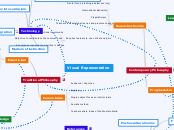Floating topic
References
Al Mousa, N. (2013). An examination of cad use in two interior design programs from the perspective of curriculum and instructors, pp. 21-37 (Master's Thesis)
Hill, A. M. (1994). Perspectives on philosophical shifts in vocational education: From realism to pragmatism and reconstructionism. Journal of Vocational and Technical Education, 10(2), 37-45.
McNeil, J. D. (2006). Contemporary curriculum in thought and action (6th ed., pp. 1-13, 24-34, 44-51, 60-73). Hoboken, NJ: John Wiley & Sons.
Ornstein, A. C. (1990/1991). Philosophy as a basis for curriculum decisions. The High School Journal, 74, 102-109.
Ornstein, A. C., & Hunkins, F. P. (2013). Curriculum: Foundations, principles, and issues (6th ed.). Boston, MA: Pearson. Read Chapter 6, pp. 149-173.
Sowell, E. J. (2005). Curriculum: An integrative introduction (3rd ed., pp. 52-54, 55-61, 81-85,103-106). Upper Saddle River, NJ: Pearson.
Technology
Subject matter as the main content source
Activities are planned according to the subject matter (key is the organization of knowledge for easier learning)
Medium of instruction
Full integration
Incorporation into curriculum
Objective is to maximize learners' achievement through a systematic approach
Looks at "how" to teach more than "what" to teach
Looks into the communication of knowledge
Problem Centered Design
Cultural centered
Pushes cultural norms
Social issues at the fore-front
Social improvement through the involvement of the schools and learners
Objective is for learners to be able to address the situation and involve them in improving society
Focus on ill-structured problem solving
Uses both society's problem and learner's life situation as a basis for curriculum design
Requires learners to use past experience to analyze the problem
Learner Centered Design
Focus on more than academics
Logical knowledge
Emotional knowledge
Social knowledge
Physical Knowledge
World Interaction
Should occur in natural settings
Student led instruction
Relevant and meaningful to the learner
Learn through subject instead of learning the subject
Process oriented instruction
Knowledge organized based on learners' perspective
Teachers work around students strengths
Learning should be integrated into learners' lives
Learning should match learner's development level
Subject Centered Design
Content rely on teachers as Subject Matter Experts and textbooks adopted by particular schools
Strong academic focus
Based on essential knowledge (later further developed into sub-categories)
Standardization
Knowledge & Content based
Heavily influenced by textbooks
Widely accepted by school systems
Contemporary Philosophy
- Focused on future
- Student centered
- Problem solving
- Holistic approach
Reconstructionism
Requires learners to use critical analysis
Encourages industrial and political changes
Objective to contribute to the common good
Local, national, and international community
Teachers look at global issues and promote change
International Educaiton
Social focus (creating a better society)
Progressivism
Education based around interests
To foster active learning
Stays away from content or knowledge focus
Holistic approach to teaching
Teachers are seen as guides
Humanistic
Pragmaticism
Traditional Philosophy
- Focus on knowledge
- Teacher central
- Historical component
- Academic and cognitive learning
Essentialism
Multi-subject approach
Students are taught by ability
Improving intellectual ability in one area transfers to others
Education of rational students
Idealism / Realism
Academic / Technological
Perennialism
Teachers share ideas of the Western World
Socratic method
Single subject focus on intellectuals
Realism
Academic / Cognitive
Visual Representation

